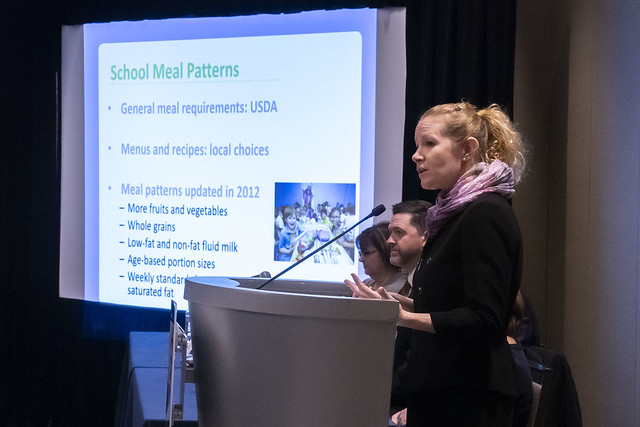
Focusing on practical, healthful options for our schoolchildren remains a key priority at USDA. Notably, Agriculture Secretary Sonny Perdue signed a May 2017 proclamation (PDF, 123 KB) to update school meals standards. It’s a process that culminated in December with a final rule on school meals flexibilities which affirm USDA’s commitment to giving schools more control over food service decisions and greater ability to offer wholesome, nutritious, and appealing meals to kids that reflect local preferences and reduce food waste.
Last month, during USDA’s 95th Annual Agricultural Outlook Forum in suburban Washington, D.C., school food and food industry professionals shared their experiences with the new flexibilities. And most critically, how the implementation of the nutrition standards work for their communities. The panel was moderated by USDA Deputy Administrator for Child Nutrition Programs, Cindy Long.
“Menus and plate appearance have improved,” said Sean Leer, Chief Executive Officer of Gold Star Foods Inc., who provides school food authorities throughout California with the foods they order. He added that the flexibilities allow schools to serve more grain products, such as non-whole grain tortillas, pasta, pizza and white rice. Now, he said, schools can serve a wider variety of grains they know their students are excited to eat.
Beginning next summer, schools will no longer have to request state exemptions to serve products that are not whole grain. The final rule allows more flexibility for serving whole grains, which will help with some of the challenges cafeterias were having, such as pastas that didn’t hold up in the food service line. Other flexibilities include:
- The option to offer flavored, low-fat milk to children participating in school meals, and to participants ages six and older in the Special Milk Program for Children (SMP) and the Child and Adult Care Food Program (CACFP); and
- Adjusting sodium targets
Gay Anderson, Child Nutrition Director of South Dakota’s Brandon Valley School District and President of the School Nutrition Association, thanked USDA for the new policy. She explained that without USDA’s flexibility on sodium standards, her school district would have had to sacrifice meal taste, like serving salad without dressing or hamburgers without ketchup. “Milk consumption drops with our students as they get older,” said Anderson, as she discussed how older kids are more likely to keep drinking milk if they have the low fat-flavored milk options. Additionally, Jill Kidd, Director of Nutrition Services for Pueblo City Schools in Colorado and Treasurer of the School Nutrition Association, applauded USDA for its efforts to work hand-in-hand with local schools to make nutritious and appetizing school lunches attainable nationwide.

Students in Prince William County Public Schools, one of Virginia’s largest school districts, are enjoying their tasty and nutritious school lunches, which is evident in the impressive 70 percent participation rate among all students. Adam Russo, the Director of School Food and Nutrition Services, detailed the district’s strategy to reduce sodium in their school meals. “We scratch cook an entrée at every level, every day,” said Russo. “We’re able to mitigate sodium levels because we’re putting exactly what we want into our products.”
The Prince William school district also directly engages students in their food production, which gets students excited about eating healthy. “We have about seventy hydroponic grow towers in classrooms. They grow basil and lettuce, then bring it to the cafeteria. Then, we chop it up and put them in our pico de gallo. It’s a big hit in the school!”
To support local efforts, USDA stands ready to offer technical assistance to schools to help them meet their students’ needs. Participants at the forum said USDA’s new meal standard flexibilities put control back in the hands of local nutrition professionals and let them do what they do best: serve meals their students can get excited about.
